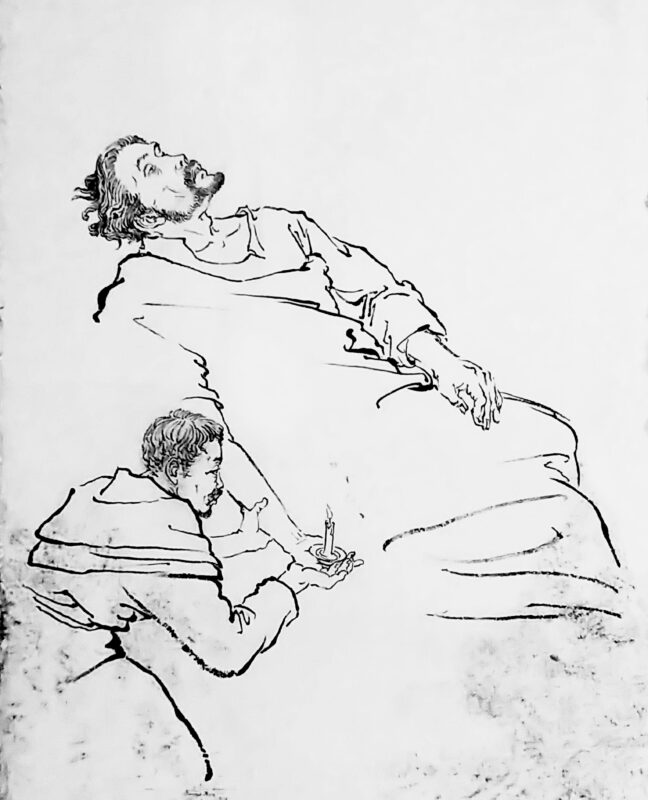
China Bridge (神州橋樑)_2019/Nov
The death of St. Francis in Sancian and the origins of the pilgrimage

St. Francis Xavier died in 1552 on Sancian Island (Shangchuan Island 上川島), longing to enter into China. Sancian is a large coastal island of Guangdong. Its located at about 150 km west of Hong Kong Island, on the opposite side of the Pearl River estuary, and is about the same size. How come Francis Xavier ended his life in this place? How did it become a place of pilgrimage?
The new Apostle of the Orient
Francis Xavier was born in 1506 in Navarre in the north of Spain, and studied in Paris. There, he became one of the seven founders of the Jesuits, together with Ignatius of Loyola. The Jesuits, thereafter, started their apostolic work in Rome.
At this time, the king of Portugal was seeking priests able to reform “by the example of their life” the religious life of the Portuguese in his kingdom and in his still expanding empire.
Since the companions of Ignatius were recommended to the king, his ambassador in Rome recruited two of them. Besides, a few years before, the Portuguese discovered in India a Christianity said to be founded by St. Thomas the Apostle, while most of the people of India and beyond never heard about the Gospel.
This discovery proved that the Apostles obeyed the command of the Lord to go “to the ends of the earth” (Acts 1:8 and Matthew 28:19; Mark 15:16), but also that they may not have reached all of it, and that the apostolic mission is to be continued.
Thus, in 1541, when Francis was sent to the eastern part of the Portuguese empire, the pope appointed him as an apostolic nuncio, to be a new St. Thomas, the Apostle of the Orient.
Travelling by the maritime road of the Portuguese, Francis Xavier arrived in Japan where he stayed for two years among Buddhist monks. He was then convinced that China was the centre of culture in Asia and regarded the evangelisation of China as a priority. But the Europeans were not allowed to enter into China at this time.
The Portuguese actually arrived in China for the first time in 1513, landing in the Pearl River estuary in a place they called Tamao, now identified as Tuen Mun, and came back for an embassy in 1517.
However, the embassy turned into a disaster in 1521, because the Portuguese also attempted to build a fortress in Tuen Mun. They were defeated and, from this time, any European landing in China would be sentenced or imprisoned for life.
The tolerated anchorage of Sancian
However, after they reached Japan in 1543, the Portuguese needed to stop over on the way and they also engaged in smuggling on the coastal islands with Chinese merchants.
Thus, the northern coast of Sancian island, which is a bit remote but not too far from the Pearl River estuary, became a seasonal haven for the Portuguese on the road to Japan and a marketplace with Guangzhou’s merchants.
The Chinese authorities tolerated it because the Portuguese were no longer a threat. To enhance this tolerance, the Portuguese avoided coming closer in from the Pearl River estuary. They did not build anything in stone in Sancian which would have been regarded as an intent to possess the place.
The death of Francis Xavier in Sancian
On his way to Japan, Francis Xavier had already stopped over in Sancian.
Two years later, hoping to enter China and end the imperial ban on western foreigners, he decided to go back to India and convinced the Portuguese viceroy of Goa to send a new Portuguese embassy to China.
The viceroy appointed Diogo Pereira as ambassador. Francis Xavier would accompany him together with Antonio, a young Chinese who could serve as interpreter. They sailed on the Santa Cruz. On the way from India to China, however, the governor of Malacca cancelled the embassy, fearing that it would jeopardise Chinese toleration of the Portuguese in Sancian.
But Francis Xavier did not give up and the governor could not stop him because he was an apostolic nuncio. Thus, he allowed the Santa Cruz to bring Francis Xavier to Sancian, but he prohibited the captain from sailing further and landing in China.
The Santa Cruz arrived in Sancian in August 1552. Francis Xavier planned to pay a Chinese merchant to bring him to Guangzhou. Even they assured him that he would be sentenced or jailed like many others before him. Besides, the Portuguese navy anchored in Sancian feared reprisal from the viceroy of Guangzhou.
They asked Francis Xavier to give them time to conclude their business and leave first. Four months later on 2 December 1552, Francis Xavier died in a hut, sick and famished, attended by his young Chinese companion, Antonio, still waiting for the time and the possibility to reach Guangzhou.
The temporary burial place
Antonio transported the coffin on a little boat, toward the middle of the northern coast, across the shallow water of Big Islet Bay (Dazhou Wan 大洲灣), and buried it on a short ledge on the slope of a mount, a few metres above the sea level, on 4 December 1552.
In February 1553, the Santa Cruz was ready to sail for Malacca. Then, Antonio checked whether the body was decomposed enough to bring the bones, but he found it uncorrupted. The body was then brought to Malacca and from there to Goa in India, where it is still venerated.
Since the body was removed, nothing remains in the temporary burial place of Sancian. Furthermore, in the life of Francis Xavier, Sancian was not the goal. Rather it would have been a stopping-place before entering into China; and it is, finally, for those who believe, the place from where he left the earth for heaven.
Sancian is thus a meaningful pilgrimage place for those who consider ourselves pilgrims on earth, coming from somewhere and having a higher or further goal.
On the threshold of the Promised Land
As their relationship with the Chinese authorities gradually improved, the Portuguese moved their seasonal anchorage closer in from Pearl River estuary, to Lampacau in 1555. This year, Father Nunez Barreto was allowed to stay in Guangzhou for three months, being thus, together with Estevao de Gois, one of the two first Jesuit missionaries allowed to enter in China. But, before fulfilling the wish of Francis Xavier, he wanted to stop in Sancian and to say the Mass on the burial place.
In the same spirit, Sancian can be compared to the threshold of Promised Land and Francis Xavier to Moses. Just as Moses brought the people up to the Promised Land, but could only see it from afar and died east of Jordan River (Deuteronomy 34,1-12), Francis Xavier died in Sancian, seeing China from afar, while the next generation of missionaries would be able to reach it.
In 1557, the Portuguese were allowed to settle permanently in Macau and the remote Sancian was totally abandoned. The Jesuits of Macau rediscovered the burial place only in 1637 and decided in 1639, to erect a memorial stele there.
On one side, the Portuguese inscription indicated the soil, mentioning that St. Francis, the Apostle of Orient, was buried there. On the other side, the Chinese inscription said that a saint came from the west and ascended from there into the sky.
Thus, this simple monument described the life and death of Francis Xavier as a matter of link between West and East as well as between earth and Heaven.
This stone, was only brought up to the burial place in 1644, was restored in 1688 and became the centre of a larger sanctuary, established on the slope and built in 1700. But, being too remote and built with poor materials, it was soon abandoned and ruined.
Actually, apart from few visitors, the pilgrimage of Sancian really started only in the second half of the 19th century when it became possible to reach Sancian from Macau with a steamer.
In 1867, the bishop of Guangzhou, Zéphyrin Guillemin, used the means of the cathedral of Guangzhou to enlarge the piece of land of the burial place and built a Gothic style memorial chapel.
This chapel, partly rebuilt in concrete by the Maryknoll Mission Society in 1932, still covers the empty burial place in which the mortal remains of St. Francis once rested and from which and are born many hopes for the evangelisation of China.
Matthieu Masson, MEP


 ENG
ENG